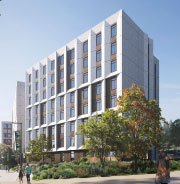Translate
Land Acknowledgment
Cal Poly sits on the traditional lands of yak titʸu titʸu yak tiłhini Northern Chumash Tribe of San Luis Obispo County and Region. yak titʸu titʸu yak tiłhini have a documented presence in this area for over 10,000 years. The tiłhini peoples have stewarded their ancestral and unceded homelands which include all of the cities, communities, federal and state open spaces within the San Luis Obispo County region. These homelands extend East into the Carrizo Plains toward Kern County, South to the Santa Maria River, North to Ragged Point, and West beyond the ocean’s shoreline in an unbroken chain of lineage, kinship, and culture.
In recognition of yak titʸu titʸu yak tiłhini, Northern Chumash Tribe of San Luis Obispo County and Region, Cal Poly proudly named its newest residential community, yakʔitʸutʸu, which means “our community” in yak titʸu titʸu yak tiłhini Northern Chumash language.
yakʔitʸutʸu opened in 2018 and features seven residential halls named after yak titʸu titʸu yak tiłhini Northern Chumash villages throughout the Central Coast region.
yakʔitʸutʸu Residential Community was recently recognized with Leadership in Energy and Environmental Design (LEED) Gold certification for being inclusive, healthy, efficient and home to cost-saving green building features.
Together, the university and yak titʸu titʸu yak tiłhini, Northern Chumash Tribe will educate future generations of Cal Poly students and local residents.
Building Names and Meanings
Download this plain text doc to your phone or desktop to quickly copy/paste names into any platform. All characters in the language are written in lowercase, including at the start of sentences and in abbreviating yakʔitʸutʸu as ytt.
| Name | Site | Meaning |
|---|---|---|
| Tribe Name | yak titʸu titʸu yak tiłhini | The people of tiłhini | |
| Housing Complex Name | yakʔitʸutʸu | Our community | |
| Building 172A | tsɨtkawayu | Cambria | Place of the horses |
| Building 172B | elewexe | Paso Robles | Named for swordfish |
| Building 172C | tiłhini | San Luis Obispo cultural capital |
Place of the full moon |
| Building 172D | tšɨłkukunɨtš | Carrizo Plain | Place of the rabbits |
| Building 172E | nipumuʔ | Nipomo | Place of the big house |
| Building 172F | tsɨtqawɨ | Morro Bay | Place of the dogs |
| Building 172G | tsɨtpxatu | Avila Beach | Place of the whales |
Project History
Cal Poly is situated within yak titʸu titʸu yak tiłhini, Northern Chumash homelands. Cal Poly, as a public institution, has the responsibility to acknowledge their presence and educate the community as a whole. As these places and villages have and always will be sites of relationship and exchange, naming the residence halls after the original village names re-centers ongoing Indigenous experiences as a first step towards acknowledging this responsibility and developing partnerships across communities of students, faculty, staff, and neighbors on the Cal Poly campus and beyond.
Education
- Village Narratives written by yak titʸu titʸu yak tiłhini, Northern Chumash Tribe
- Indigenous Walking Tour of Cal Poly, written by Amy Contreras, Sophie Martyrossian, Becca Lucas, M.S., M.A., Lydia Heberling, Ph.D. (2024)
- Learn the story behind the "Rooted in Native Knowledge" Mural which now permanently resides in yakʔitʸutʸu Native & Indigenous Cultural Center on campus.
Pronunciation
At first glance, the names of our newest housing community might look and sound a little unfamiliar. They’re written in tiłhini, the Northern Chumash language. They incorporate some characters you might not have written before and some sounds you might not have used before. That’s okay! As any language-learner can tell you, it takes practice before you can wrap your tongue around new words — and even more practice before you can say those words with confidence.
Take some time to get familiar with the names of this community and explore their meanings. Here are some resources to get you started:
- Hear pronunciations via the Cal Poly Now App
- Video: Hear Pronunciations, modern locations and meanings
- Video: An in-depth look at the pronunciations
- Alphabet (PDF): learn the Chumash letters and how to say them
Resources
- Map (PDF) practice worksheet
- Map (PDF) with names and meanings
- Keyboard Installation for Mac and PC
- yakʔitʸutʸu Office 365 add-In
Project Partners
University Housing is grateful to all the partners who worked so hard over the years to take yakʔitʸutʸu housing community from a concept to a home for nearly 1,500 first-year Cal Poly students:
- yak titʸu titʸu yak tiłhini Tribal project team
- Northern Chumash Tribal Council
- California Indian Education Association
- American Indian and Indigenous Faculty Staff Association
- American Indian Student Association
- Inter Housing Council
- Council Cross Cultural Centers
- Office of the President Vice President for Student Affairs
Green Building Features
Cal Poly incorporated many green building features into this project with consultation from yak titʸu titʸu yak tiłhini Tribal team.



